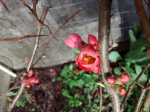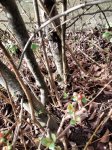marc206
Mame
I just noticed this quince in my stepdads yard. He said I could take it if I had a good plant to put there. It has many trunks and has been there for 30 plus years. Trunks range from and inch to two. What do you think? Does anyone know the cultivar?
These are the best picturesi could get while I was there. Hope you like.
These are the best picturesi could get while I was there. Hope you like.





